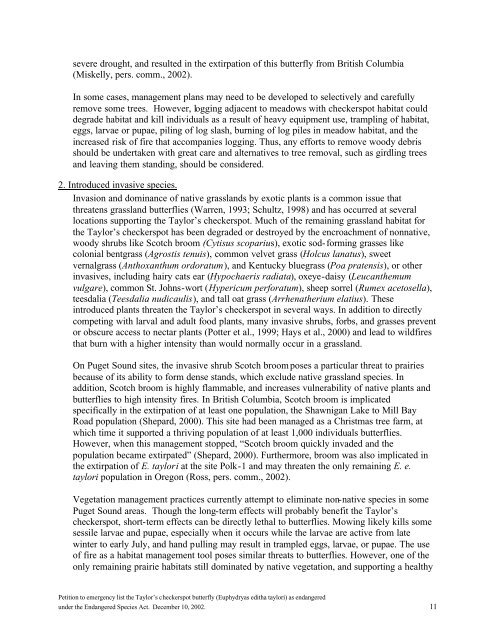petition to emergency list taylor's (whulge) checkerspot - The Xerces ...
petition to emergency list taylor's (whulge) checkerspot - The Xerces ...
petition to emergency list taylor's (whulge) checkerspot - The Xerces ...
Create successful ePaper yourself
Turn your PDF publications into a flip-book with our unique Google optimized e-Paper software.
severe drought, and resulted in the extirpation of this butterfly from British Columbia<br />
(Miskelly, pers. comm., 2002).<br />
In some cases, management plans may need <strong>to</strong> be developed <strong>to</strong> selectively and carefully<br />
remove some trees. However, logging adjacent <strong>to</strong> meadows with <strong>checkerspot</strong> habitat could<br />
degrade habitat and kill individuals as a result of heavy equipment use, trampling of habitat,<br />
eggs, larvae or pupae, piling of log slash, burning of log piles in meadow habitat, and the<br />
increased risk of fire that accompanies logging. Thus, any efforts <strong>to</strong> remove woody debris<br />
should be undertaken with great care and alternatives <strong>to</strong> tree removal, such as girdling trees<br />
and leaving them standing, should be considered.<br />
2. Introduced invasive species.<br />
Invasion and dominance of native grasslands by exotic plants is a common issue that<br />
threatens grassland butterflies (Warren, 1993; Schultz, 1998) and has occurred at several<br />
locations supporting the Taylor’s <strong>checkerspot</strong>. Much of the remaining grassland habitat for<br />
the Taylor’s <strong>checkerspot</strong> has been degraded or destroyed by the encroachment of nonnative,<br />
woody shrubs like Scotch broom (Cytisus scoparius), exotic sod-forming grasses like<br />
colonial bentgrass (Agrostis tenuis), common velvet grass (Holcus lanatus), sweet<br />
vernalgrass (Anthoxanthum ordoratum), and Kentucky bluegrass (Poa pratensis), or other<br />
invasives, including hairy cats ear (Hypochaeris radiata), oxeye-daisy (Leucanthemum<br />
vulgare), common St. Johns-wort (Hypericum perforatum), sheep sorrel (Rumex ace<strong>to</strong>sella),<br />
teesdalia (Teesdalia nudicaulis), and tall oat grass (Arrhenatherium elatius). <strong>The</strong>se<br />
introduced plants threaten the Taylor’s <strong>checkerspot</strong> in several ways. In addition <strong>to</strong> directly<br />
competing with larval and adult food plants, many invasive shrubs, forbs, and grasses prevent<br />
or obscure access <strong>to</strong> nectar plants (Potter et al., 1999; Hays et al., 2000) and lead <strong>to</strong> wildfires<br />
that burn with a higher intensity than would normally occur in a grassland.<br />
On Puget Sound sites, the invasive shrub Scotch broom poses a particular threat <strong>to</strong> prairies<br />
because of its ability <strong>to</strong> form dense stands, which exclude native grassland species. In<br />
addition, Scotch broom is highly flammable, and increases vulnerability of native plants and<br />
butterflies <strong>to</strong> high intensity fires. In British Columbia, Scotch broom is implicated<br />
specifically in the extirpation of at least one population, the Shawnigan Lake <strong>to</strong> Mill Bay<br />
Road population (Shepard, 2000). This site had been managed as a Christmas tree farm, at<br />
which time it supported a thriving population of at least 1,000 individuals butterflies.<br />
However, when this management s<strong>to</strong>pped, “Scotch broom quickly invaded and the<br />
population became extirpated” (Shepard, 2000). Furthermore, broom was also implicated in<br />
the extirpation of E. taylori at the site Polk-1 and may threaten the only remaining E. e.<br />
taylori population in Oregon (Ross, pers. comm., 2002).<br />
Vegetation management practices currently attempt <strong>to</strong> eliminate non-native species in some<br />
Puget Sound areas. Though the long-term effects will probably benefit the Taylor’s<br />
<strong>checkerspot</strong>, short-term effects can be directly lethal <strong>to</strong> butterflies. Mowing likely kills some<br />
sessile larvae and pupae, especially when it occurs while the larvae are active from late<br />
winter <strong>to</strong> early July, and hand pulling may result in trampled eggs, larvae, or pupae. <strong>The</strong> use<br />
of fire as a habitat management <strong>to</strong>ol poses similar threats <strong>to</strong> butterflies. However, one of the<br />
only remaining prairie habitats still dominated by native vegetation, and supporting a healthy<br />
Petition <strong>to</strong> <strong>emergency</strong> <strong>list</strong> the Taylor’s <strong>checkerspot</strong> butterfly (Euphydryas editha taylori) as endangered<br />
under the Endangered Species Act. December 10, 2002. 11
















